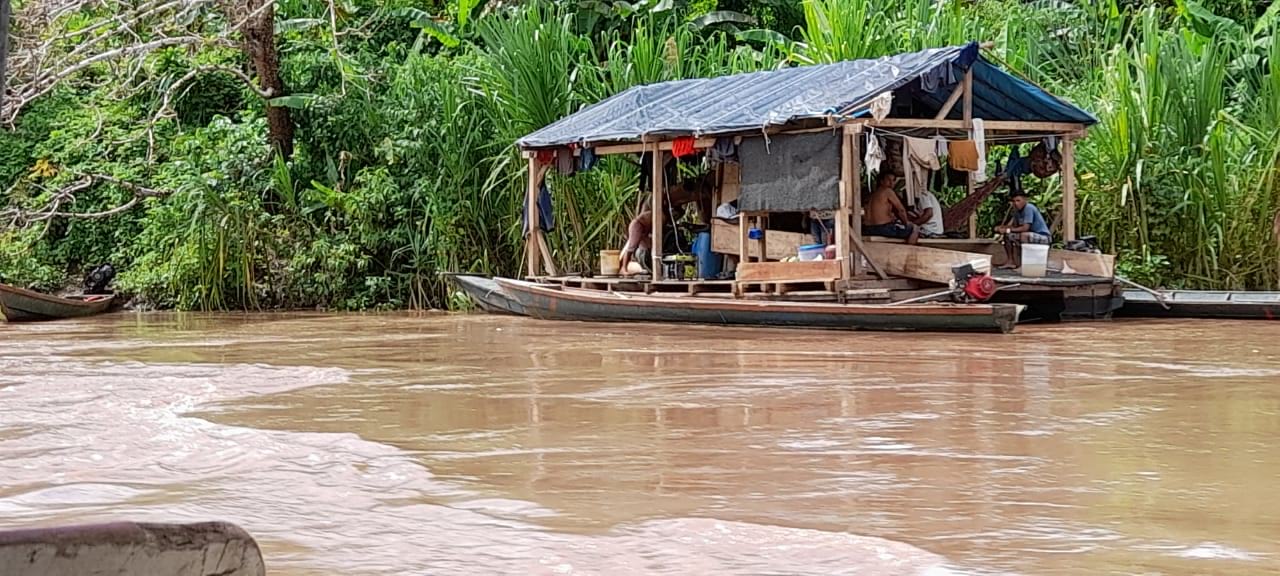In the middle of the Awajún territory, the permanent dredging activity and the use of mercury in gold mining activities generate constant contamination of the river and therefore, the water is no longer fit for human consumption. However, the inhabitants of the basin continue to eat the contaminated fish, which directly affects their health. The latest studies reveal that one out of every three children is anemic and has high rates of chronic child malnutrition. Faced with this worrying situation, the Awajún communities are trying to find solutions in an organized manner.
In the middle of the Awajún territory, the permanent dredging activity and the use of mercury in gold mining activities generate constant contamination of the river and therefore, the water is no longer fit for human consumption. However, the inhabitants of the basin continue to eat the contaminated fish, which directly affects their health. The latest studies reveal that one out of every three children is anemic and has high rates of chronic child malnutrition. Faced with this worrying situation, the Awajún communities are trying to find solutions in an organized manner.
Since the 1940s, artisanal miners knew of the existence of alluvial gold along the Cenepa River, and its abundance attracted a group of Ecuadorian citizens who entered Peruvian territory. Among them was David Samaniego, who decided to stay for good, captivated by the landscape of the basin and its abundant fauna. Don David had initially visited the Numpatkaim and Comaina valleys, two tributaries of the Cenepa whose streams flow from the foothills of the Cordillera de Cóndor.
He recalls that since that time, the heads in command of the border military detachment confided to him that they knew about the good profitability of the gold in the area and on more than one occasion they conducted business for short periods of time. In the 1980s, Don David was the only person who knew about artisanal gold panning, an activity that from time to time solved his economic problems. But he never suspected that gold would be the cause of the misfortune that would cloud the waters of the Cenepa, in the middle of Awajún territory, to the point of making them unfit for human consumption.
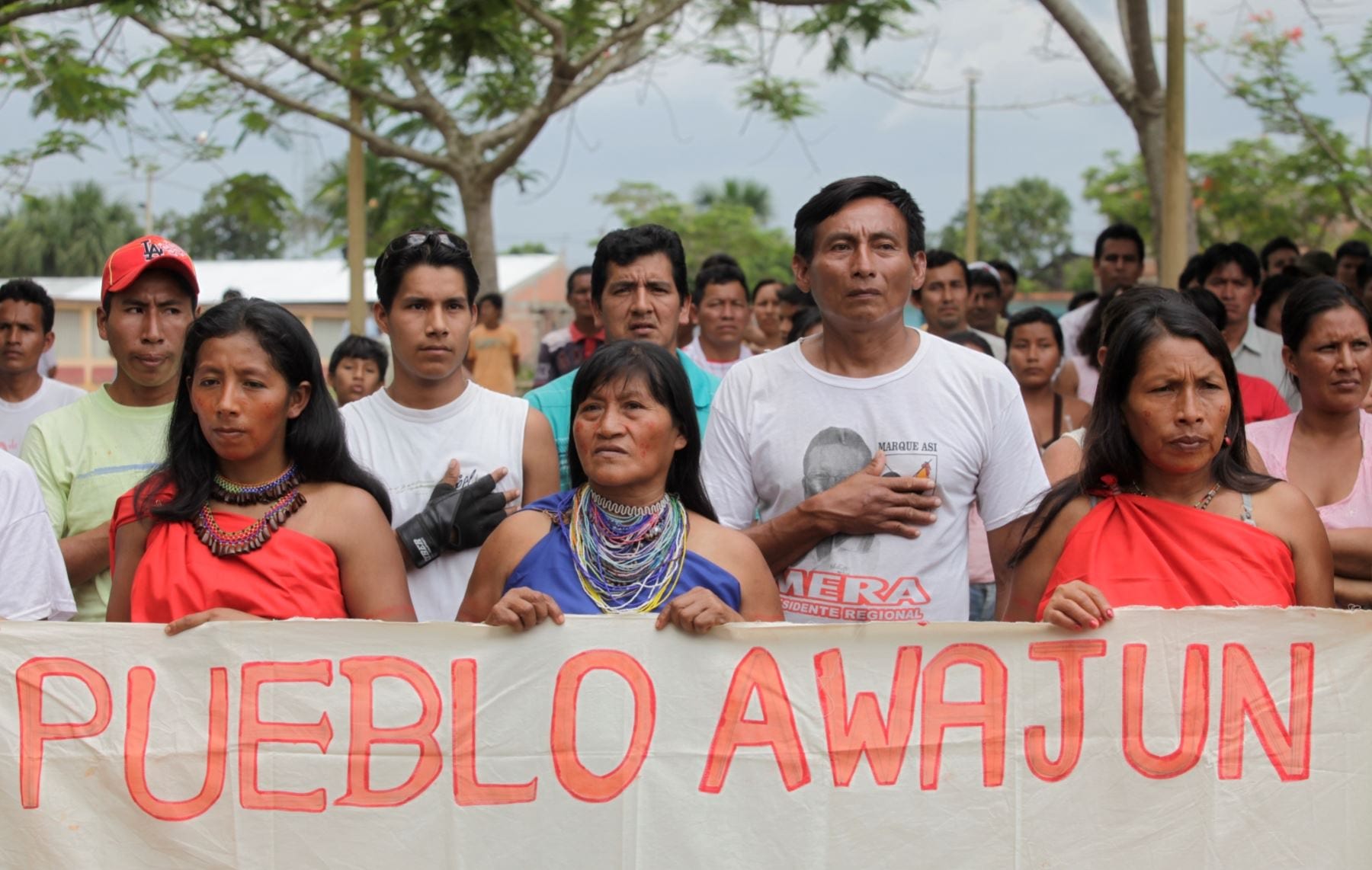
The Awajún people living in the Cenepa River basin resist the contamination generated by illegal gold mining. Photo: Andina
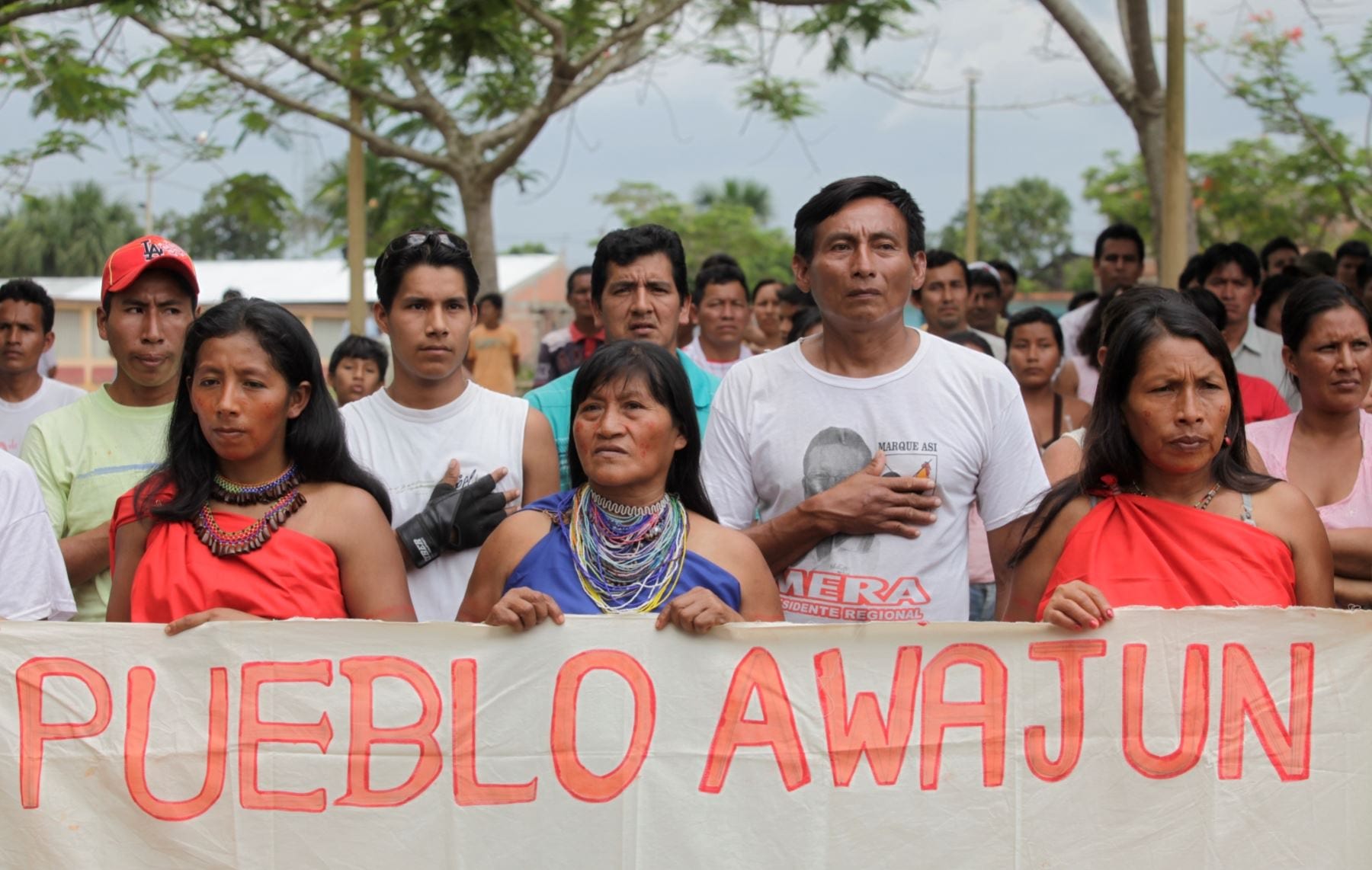
The Awajún people living in the Cenepa River basin resist the contamination generated by illegal gold mining. Photo: Andina
From a protected natural area to the plundering of illegal mining
After peace was signed between Peru and Ecuador in 1998, the Peruvian State proposed, through the National Institute of Natural Resources (INRENA), the creation of a National Park in the Cordillera de Cóndor, along the border and adjacent areas. This initiative was in conflict with several previous titling requests submitted by the border Awajún communities. After arduous dialogue processes and the reservation of an important space for the pending titling, it was agreed to create a Natural Protected Area in a territorial extension of almost 153,000 hectares. The Awajún and the Wampis reached this agreement as a strategy to protect the border from mining incursions in the headwaters of the rivers that originate in the mountain range.
Despite the agreement, the Ichigkat Muja National Park was only created in 2007 with an area of only 88,477 hectares. The remaining hectares, approximately 65,000 hectares, were reserved for mining claims. Since then, 111 concessions have been granted in the area. Conservation International, the organization that had conducted the original studies for the park's creation, had characterized this mining area as the most biologically diverse in the Cordillera de Cóndor. Soon after, the Organization for the Development of the Cenepa Border Communities (ODECOFROC) filed a legal action to annul the concessions because the Peruvian government did not respect the agreements reached.
The Awajún communities had good reason to be afraid. Since 2010, mining promoted by illegal groups that had already participated in the destruction of the Madre de Dios River basin entered the Cenepa basin. Since then, the affected population has requested interdiction actions: a legal figure to eradicate illegal mining activity. After 12 years of this activity in the Cenepa watershed, no effective measures have ever been taken to address the population's demand for the right to a healthy environment. The Cenepa area is inhabited by approximately 10,000 Indigenous Awajún people.
The construction of self-managed control measures
The Cenepa basin is formed by water sources that descend from the Cordillera de Cóndor, including the Numpatkaim and the Comaina. The Cordillera is the border reference that separates the Peruvian territory from Ecuador. The Cenepa basin and its tributary rivers are populated by Awajún inhabitants living in more than 50 communities. Along the Comaina River are three communities that make up the Alto Comaina Community Development Organization (ODECOAC) and the Awajún Indigenous Federation of Alto Comainas and Sawientsa (FIACSA). Eight communities in the Numpatkaim River valley are organized in ODICINAC. ODECOFROC brings together the largest number of communities located on the Cenepa River itself.
The main means of communication in the area is river transportation. It is estimated that the Cenepa River extends approximately 210 kilometers from its source in the Cordillera de Cóndor to its mouth at the Marañón River. The population located on the Cenepa's main stem travels daily in canoes propelled by peque peque motors and, occasionally, rafts for short trips. However, there has been a notable increase in the use of outboard motor boats as a modern means of transportation in the last 10 years.
Mining is a threat because it puts the biodiversity at risk and, after 12 years of activity, has rendered the waters of the Cenepa unfit for human consumption due to high mercury levels.
Mining is a threat because it has made the waters of the Cenepa unfit for human consumption due to high levels of mercury.
Following its constitution in December 2021, the Awajún Autonomous Territorial Government (GTAA) held an extraordinary assembly with the Organization for the Development of the Cenepa Border Communities (ODECOFROC) on April 6 and 7, 2022. At the meeting, the communities addressed the issue of illegal mining as one of the priority problems. In the ordinary assembly of ODECOFROC, the local authorities agreed to take self-managed control measures through the Self-Defense Committee, made up of Awajún members from different communities.
As a first step, the Committee proceeded to detain two boats that entered the Cenepa River. The detained illegal miners were handed over to State authorities. However, when they were released, the decision was understood as an act of impunity that caused more miners to enter the Cenepa basin. There are currently 45 dredges being used by illegal miners to extract gold from the riverbanks and beaches. This has caused heavy deforestation of the area. For the GTAA, mining is a threat because it puts biodiversity of the region at risk and, after 12 years of activity, has rendered the waters of the Cenepa unfit for human consumption due its high levels of mercury.
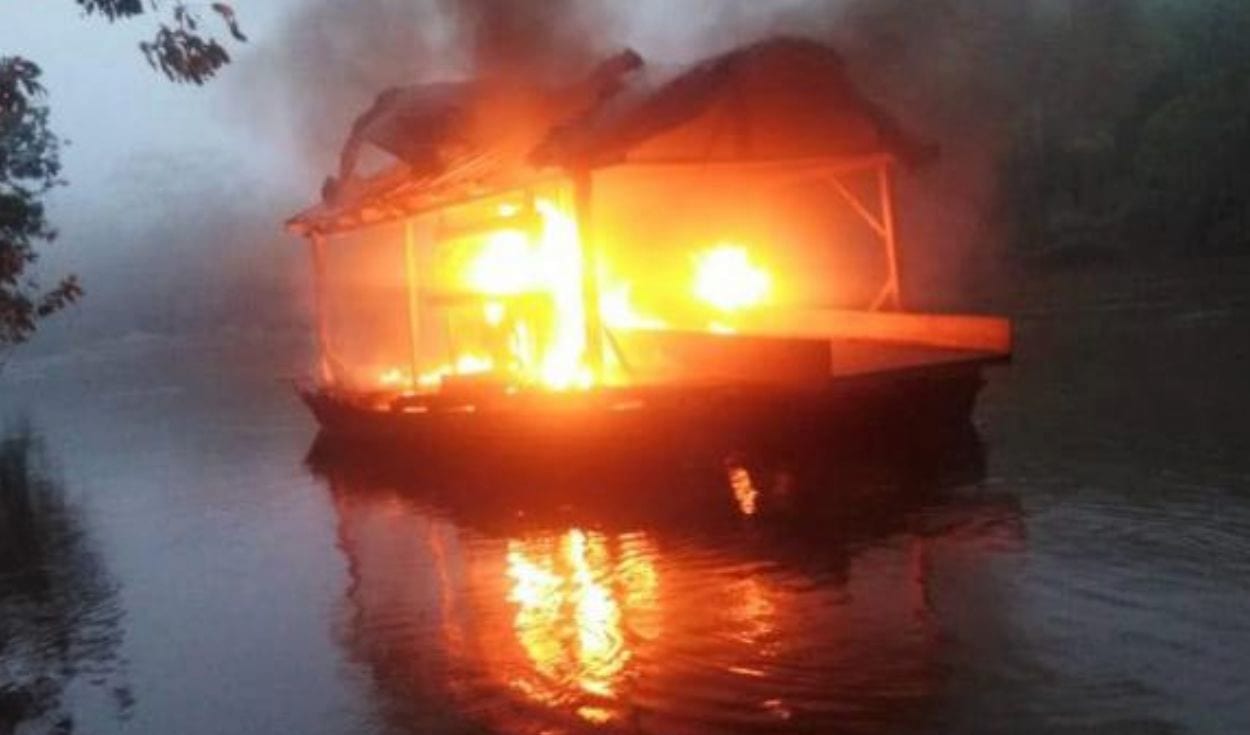
Tired of the State's inaction, the Awajún decided to destroy two illegal mining dredges and detained five operators who were later handed over to the authorities. Photo: Aidesep
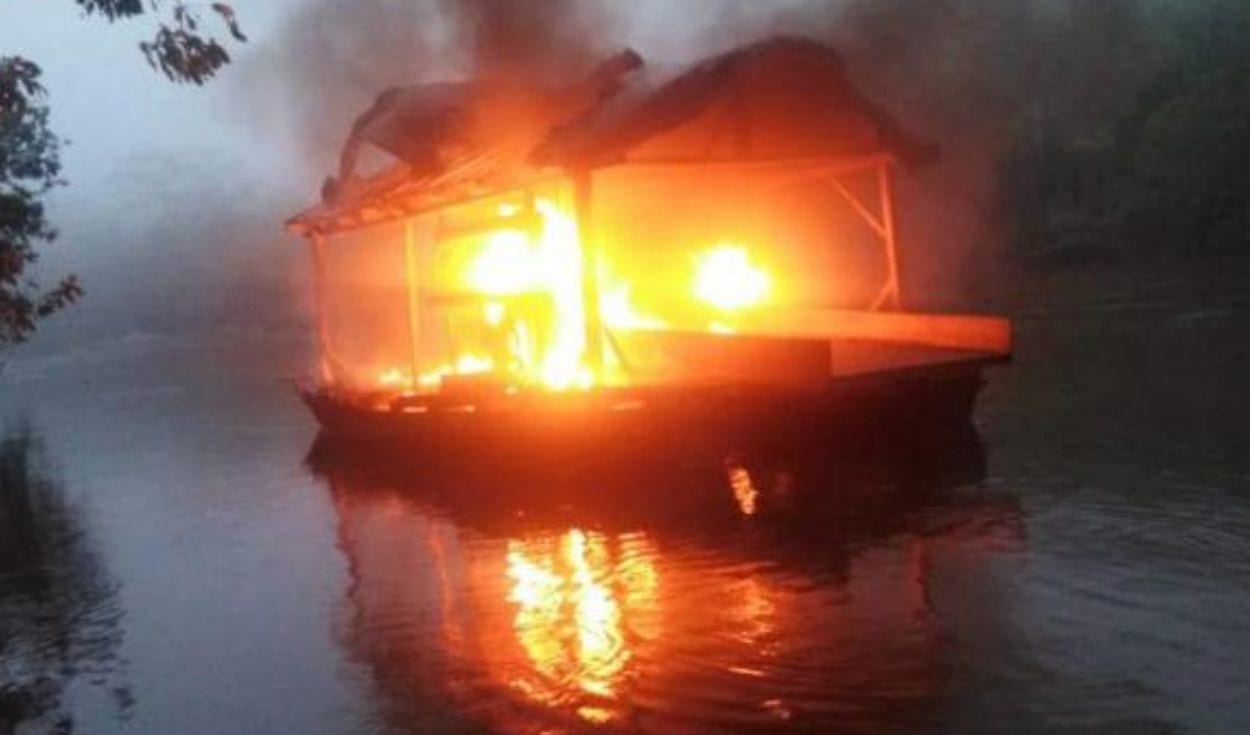
Tired of the State's inaction, the Awajún decided to destroy two illegal mining dredges and detained five operators who were later handed over to the authorities. Photo: Aidesep
Contamination of food sources
The Cenepa River is also the name of the district that was created on September 1, 1941 during the first presidency of Manuel Prado Ugarteche, after the war with Ecuador. Cenepa belongs to the province of Condorcanqui, in the department of Amazonas. With population growth, in the last 30 years the district has been suffering from a shortage of basic subsistence resources that directly affects the health of the population, which depends on the food provided by its forests and rivers.
This impact of nature's affectation has already been recorded by public statistics. According to 2018 data from the Nutritional Status Information System (SIEN), under the Ministry of Health, the provinces of the Amazon region with the highest levels of anemia in children under 3 years of age are Bagua, Condorcanqui and Chachapoyas: one in three children who are treated in health centers has anemia. Regarding chronic child malnutrition, in Condorcanqui two out of every five children under 5 years of age are malnourished (39.65%); in Bagua the figure reaches 29.1% and in Luya, 21.1%.
Although in the last 10 years the population of El Cenepa has promoted the development of productive activities to recover their food diet, they are increasingly dependent on products brought in by foreign traders, who established an alliance with gold prospectors from Madre de Dios to introduce illegal alluvial mining exploitation systems. In turn, they bribed community leaders in order to gradually undermine the organization of the communities and penetrate their territories.
After 12 years of intensive gold mining activity, no community consumes the river water, but they do eat the contaminated fish and this has a direct impact on the degradation of public health.
After 12 years of intensive gold mining activity, no community consumes the river water, but they do eat the contaminated fish.
In 2021, El Cenepa's annual budget did not exceed 7,000,000 soles (approximately US$ 1,500,000) and was only enough to cover bureaucratic expenses with very few, if any, possibilities for social investment. To face the crisis caused by population growth, the communities and their representative organizations were forced to negotiate with international cooperation agencies to develop alternative projects: promotion of cocoa cultivation, promotion of handicrafts, participation of women and construction of family fish farms.
The Cenepa River has become an alluvial mining territory and the quality of its water has decreased due to constant contamination. Mercury and dredges seriously affect the aquatic fauna and generate a double effect: the decrease in fishing that serves for the basic subsistence of the population and water that is no longer consumable as it used to be. Currently, after 12 years of intensive gold mining, no community consumes the river water, but they do eat the contaminated fish. This has a direct impact on the degradation of the public health of the inhabitants, especially the children.

Water contamination and forest degradation are detrimental to food supply. Official statistics show an increase in cases of anemia and chronic malnutrition. Photo: América Tevé

Water contamination and forest degradation are detrimental to food supply. Official statistics show an increase in cases of anemia and chronic malnutrition. Photo: América Tevé
State inaction
Based on other experiences in the Amazon, expecting the State alone to do all the work is illusory because its action is almost nil, which encourages illegal activity to proliferate and take root in society. In the long run, this practice can end up destroying the Cenepa forest, as has happened in Madre de Dios with more than 80,000 hectares of forest destroyed, especially in Huepetuhe. The current damage and the prospect of a worrying future have motivated the population to take action and seek solutions in an organized manner.
The consequences of illegal mining transcend the boundaries of Awajún values and principles by altering life in social, cultural and environmental aspects. The material and spiritual ties that hold the community together are undermined. While Awajún subsistence depends on control of the territory and its natural resources, the culture of extractivism, imposed by external agents and facilitated by the State's inaction, affects the self-government of the locals. The community does not have the appropriate resources to deal with the situation, nor the logistics to carry out efficient surveillance or the mobilization capacity to protect the river.
Rivers, forests and fertile soils are now being affected by mining activity, destroying their habitats and basic livelihoods.
Rivers, forests and fertile soils are being affected by mining activity, destroying their habitats and basic livelihoods.
Although the Awajún people of the Cenepa have been inserting themselves into the market economy since the 1950s, their main material support continues to be the resources of their forests and fertile soils that allow for the development of agriculture along the riverbanks. It is precisely the rivers, forests and fertile soils that are now being affected by mining activities that destroy their habitats and their basic means of subsistence.
On June 24, one month after the Self-Defense Committee stopped two mining vessels, the government decreed a state of emergency in the province of Condorcanqui. Despite the insistent request for an Intervention Plan to be developed with the Awajún people, the State has not yet adopted sustainable measures nor has it proposed effective alternatives to definitively eradicate illegal mining in the basin. In fact, on the beaches adjacent to a military detachment in the area, the illegal miners' dredges continue to operate quietly. We would not like to think that the testimony of Mr. David Samaniego is a shadow of the past that continues as a nightmare for the present generation.
